
Traffic control plans for temporary traffic works are essential to ensure the safety of both workers and road users during construction or maintenance activities on or near roadways. These plans typically involve a set of measures that aim to minimise the impact of the work on traffic flow, while also keeping workers and the public safe.
Here are some key considerations when developing a traffic control plan for temporary traffic works:
- Identify the scope of the project: This involves determining the location and extent of the work and the expected duration of the project. This information will help determine the level of traffic control required.
- Assess the risks: Consider the type of traffic and its volume, speed limits, road configuration, and any nearby obstacles or hazards. This information will help determine the appropriate traffic control measures to put in place.
- Develop a traffic control plan: Based on the risk assessment, develop a traffic control plan that outlines the traffic control measures required to ensure safe traffic flow through the work zone. This may include signage, barriers, traffic cones, and flaggers to direct traffic. Use traffic control plan software such as Road Manager to help you create the best traffic control plan.
- Communicate the plan: Ensure that all relevant stakeholders are aware of the traffic control plan and understand their roles and responsibilities. This includes workers, traffic control personnel, and road users.
- Monitor and adjust as necessary: Regularly monitor the traffic control plan to ensure it is working as intended and adjust as necessary based on changing conditions.
Overall, effective traffic control plans for temporary traffic works require careful planning, attention to detail, and clear communication to ensure the safety of all involved.
Leave a Comment
Your email address will not be published. Required fields are marked *

